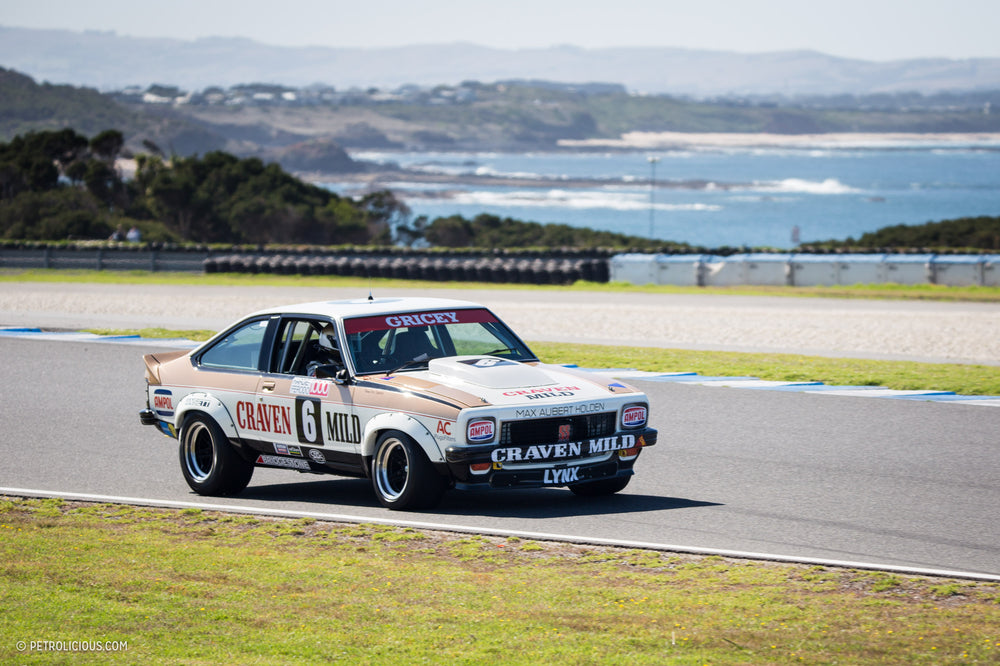I met Tony Sawford and his good mate and fellow group C racer, Neville Butler, trackside at the recent Phillip Island Classic race meeting. Prior to their two scheduled races for the day, these gentlemen were doing their best to relax as they waited eagerly in the pits next to Tony’s beautifully aggressive Holden Torana A9X Hatchback wearing its crisp white and gold livery.



Stewart Perry: Tony, how did you end up racing a historic A9X Torana?
Tony Sawford: I’ve been a Torana nut for years. I remember watching Peter Brock, the Morrises, and all the others racing Toranas back in the late ’70s. Winning the Australian Touring Car Championships in ’78 and ’79, the Bathurst victories; it was a great car, and I wanted to own an A9X ever since. I bought a road car in ’97 which I still have and am restoring at the moment, and then I started looking for an A9X race car. Initially I bought another one, known as the “Master Brewer” car, and after that purchase the previous owner of the “Craven Mild” car called me for some advice. We got to talking and I made him an offer and ended up getting the car.
SP: So giving advice turned into giving him a check for the car. Can you tell me some more about it now that you’ve had the chance to drive one finally?
TS: It is a genuine period race car with history—all cars that race in Group C at the Phillip Island events have to be the genuine cars that raced in the period. It was originally raced under Bond’s “Gotcha” livery between 1977 and 1979, but during the 1979 season top-level driver Alan Grice wrote off two cars and found himself short of something to compete with only six weeks before Bathurst. This car was acquired and rebuilt into the “Craven Mild” specification you see it in today. Alan took two Toranas to the 1979 Bathurst 1000 and ran them both in qualifying. He qualified in the top 10 in this car, but the other car was faster so my car stayed in the pits as the team’s spare.


SP: That’s nice that it’s being used on the track once again. What was the path from it’s period racing days to your ownership then?
TS: Alan Grice later sold the car to a chiropractor in Sydney who regularly treated both him and fellow Australian race legend Frank Gardner. That fella used it as a road car about for two years and then it was sold back into sports sedan racing and competed in the ’81, ’82, and ’83 seasons. It must have been pretty wild to drive on the street to and from the office!
So after retiring from racing for the second time in 1983, it did the occasional club track day but other than that it was used as a road car. Then I bought it back in 2005. The stickers had been peeled off, and it had been fitted with standard seats, seat belts, and rear-exiting exhaust, but other than that it was exactly as it was at Bathurst in 1979.


SP: How has it the car been since you purchased it? Have you done a lot of work to it aside from getting it back to it’s racing spec?
TS: Initially we rebuilt the mechanicals and just got it back on the track, but after a minor altercation 18 months ago, we did a full rotisserie restoration and this is the car’s first event out in 18 months!
SP: I know the A9X was a Holden homologation special for racing, but how many did they actually make?
TS: Don’t hold me to exact numbers please, but in terms of road cars I believe they made about 300 sedans, 100 hatches, with an additional 28 race cars, 8 of which were sedans with the rest being hatchbacks like mine.

SP: And what goes into preparing the car for Group C?
TS: So much work goes into researching the history of the cars. The class rules require that they are 100% as they were back in the day. So there are no big valve heads, modern carbies, or Gilmer drives here. I even went as far as having an original Holden water pump rebuilt rather than fitting a reproduction one.
When I built the engine, the eligibility officer came over to my house and placed seals on it so that the scrutineers can be sure that there are no non-period parts in there.



SP: That’s some dedication, but it pays off when you get to drive a car that’s as close as possible to the ones you saw racing many years ago. So, what is it like racing in Group C with this car?
Neville Butler: It’s like a childhood dream come true. We are doing it just like privateers did back in the day. All the work on this car is done by Tony in his small suburban garage. He builds engines, gearboxes, etc. You name it, he does it. The fact that the category is all original race cars is amazing. It really is high speed heritage!
SP: That sounds like a way to make a lot of memories, but can you tell me about a highlight of your time racing in the category?
TS: Definitely when Peter Brock came and raced with us the last year he was alive. He was out there in the Martini and Warren Smith A9X Hatchback, which was a similar specification to mine. Despite never having driven the car before, he was four seconds faster than the rest of us, and he was up there mixing it with the Group A cars that we share the races with. I’ll never forget that.






















































